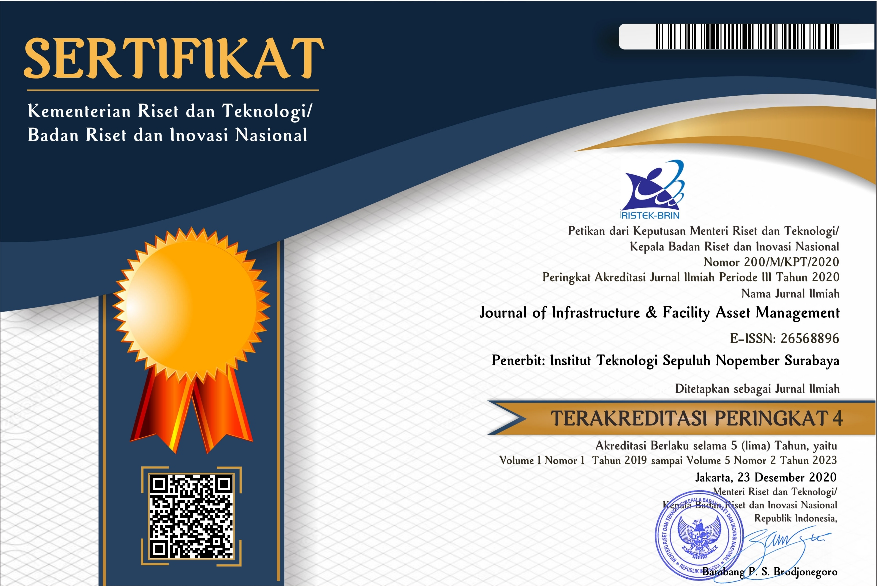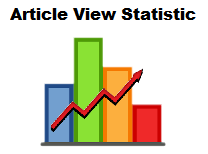The Importance of Awareness of Heritage Building's Seismic Behaviors : Specific on Pagoda-Type Structure
Abstract
The importance of building cultural heritage. A place where historical stories, cultural values, places of worship, symbols of struggle and even now are transformed into tourist attractions and educational facilities. Keeping this building good and well maintained is a good thing to do. The purpose of this paper is to enhance awareness of the importance of knowledge about heritage buildings from the viewpoint of building structure and seismicity. In addition, as a research initiation on the performance of the existing pagoda structure in Bali, Meru, going forward. This paper reviews several studies of pagodas in numerous countries, both in terms of structural design, influence and structure on earthquake response, damage, and handling in terms of reinforcement and maintenance. Comprehensively summarizes the studies that have been done, this facilitates understanding of existing studies. With the hope of being able, to trigger and encourage studies on building cultural heritage in Indonesia in general and Bali in particular. Research on the pagoda in Bali in the future is highly expected and needs to be done.
Full Text:
PDFReferences
Endo, Y. & Hanazato, T. (2018). “Seismic Analysis of a Three-Tiered Pagoda Temple Affected by the 2015 Seismic Analysis of a Three-Tiered Pagoda Temple Affected by the 2015 Gorkha Earthquake”. International Journal of Architectural Heritage, 1–14. https://doi.org/10.1080/15583058.2018.1550534
Gunawarman, R. (2016). “Teknologi Bangunan Tradisional Meru Tumpang Lima Pura Puseh dan Beji Desa Adat Seminyak”. UNDAGI Jurnal Arsitektur Warmadewa, Vol 4, 58-62.
Hanazato, T., Fujita, K. & Sakamoto, I. (2004). “Analysis of Earthquake Resistance of Five-Storied Timber Pagoda”. 13 Th World Conference on Earthquake Engineering, (1223), 79–95.
Nakahara, K., Hisatoku, T. & Nagase, T. (2000). “Earthquake Response of Ancient Five-Story Pagoda Structure of Horyu-Ji Temple in Japan”. 12 Th World Conference on Earthquake Engineering, (1229), 1–6.
Paramadhyaksa, I. N. W. (2010). “Makna filosofis keberadaan ornamen Bedawang Nala di Dasar Bangunan Meru”. Filsafat, 20(1), 45–55. https://doi.org/https://doi.org/10.22146/ jf.3432
Paramadhyaksa, I. N. W. (2016). “Konsepsi Panca Mahabhuta dalam Perwujudan Arsitektur Tradisional Bali”, Jurnal ArchiGreen Vol. 3 No. 5 (2016) 1–14.
PerdaProvBali 4/14. Peraturan Daerah Provinsi Bali Nomor 4 Tahun 2014 tentang Pelestarian Warisan Budaya Bali.
Sonda, D., Bothara, J., Chesi, C., Sumini, V., Tonna, S., & Planas, B. (2017). “Analysis of the Seismic Performance of a Strengthened Pagoda Temple during Gorkha Earthquake”. 16 The World Conference on Earthquake Engineering, (4232).
Suprayitno, H. & Soemitro, R.A.A. (2018). “Preliminary Reflexion on Basic Principle of Infrastructure Asset Management”. Jurnal Manajemen Aset Infrastruktur & Fasilitas, Vol. 2, No. 1, Maret 2018, Hal. : 1-10.
Toshikazu, H., Chikahiro, M., & Yasushi, N. (2010). “Seismic and Wind Performance of Five-Storied Pagoda of Timber Heritage Structure”. Advanced Materials Research, 134, 79–95. https://doi.org/10.4028/www.scientific.net/AMR.133-134.79
UU 11/10. Undang-Undang Republik Indonesia Nomor 11 Tahun 2010 tentang Cagar Budaya.
William, R., & Yuswadi, I., (2017). “The Architecture of Pagodas Viewed from the Angle of Site Lay-Out, Proportion, and Symbolization”, Jurnal Riset Arsitektur Vol 1, (2), April 2017; 192-208.
Yuan, J., & Li, S. (2001). “Analysis and Investigation of Seismic Behavior for Multistory-Pavilion Ancient Pagodas in China”. Transactions on the Built Environment, 55.
DOI: http://dx.doi.org/10.12962%2Fjifam.v2i1.6903
Refbacks
- There are currently no refbacks.
Visitor :
Flag Counter

Journal Of Infrastructure & Facility Asset Management by Institut Teknologi Sepuluh Nopember is licensed under a Creative Commons Attribution-ShareAlike 4.0 International License.
http://earthlearning.unimol.it/
Kementerian Pemberdayaan Perempuan dan Perlindungan Anak Indonesia
BRIN - Badan Riset dan Inovasi Nasional
https://www.cityofnorthfield.org/
Website Resmi Bogor TimurIndonesia
TabolakkabResmi Kabupaten Konawe Selatan
Rumah Pangan KitaDistribusi Pangan Resmi Peluang Usaha Modal Terjangkau
Direktorat Jenderal PajakTerkini Dan Terpercaya
Kabupaten MadiunIndonesia
Rumah Sakit Umum Kabupaten KendalMasyarakat Selalu Hidup Sehat Dan Bahagia
Kadin SumateraSistem Informasi Kamar Dagang Industri Indonesia
Kadin Sumatera SelatanSistem Informasi Kamar Dagang Industri Indonesia
k
Kota DemakTerkini Dan Terbaru Hari Ini
Berita Kota MadiunTerkini dan Terbaru Hari ini
RS UIUniversitas Indonesia
Rumah Sakit Umum RSUD CicalengkaProvinsi Jawa Barat
Children's NationalHospital - Ranked Top 10 in the Nation
Murni Teguh Memorial HospitalKota Jakarta
Mayo ClinicRochester,Minnesota
RS PersahabatanKota Jakarta Timur
RS Adam Malik MedanTerjangkau, Efisien, Nyaman
(RSUD) Dr. Dradjat PrawiranegaraKabupaten Serang
https://kemkespapuaselatan.id/
https://kemkespapuapegunungan.id/
https://kemkesbengkuluprov.id/
BMKG - Badan Meteorologi, Klimatologi, dan Geofisika Indonesia





